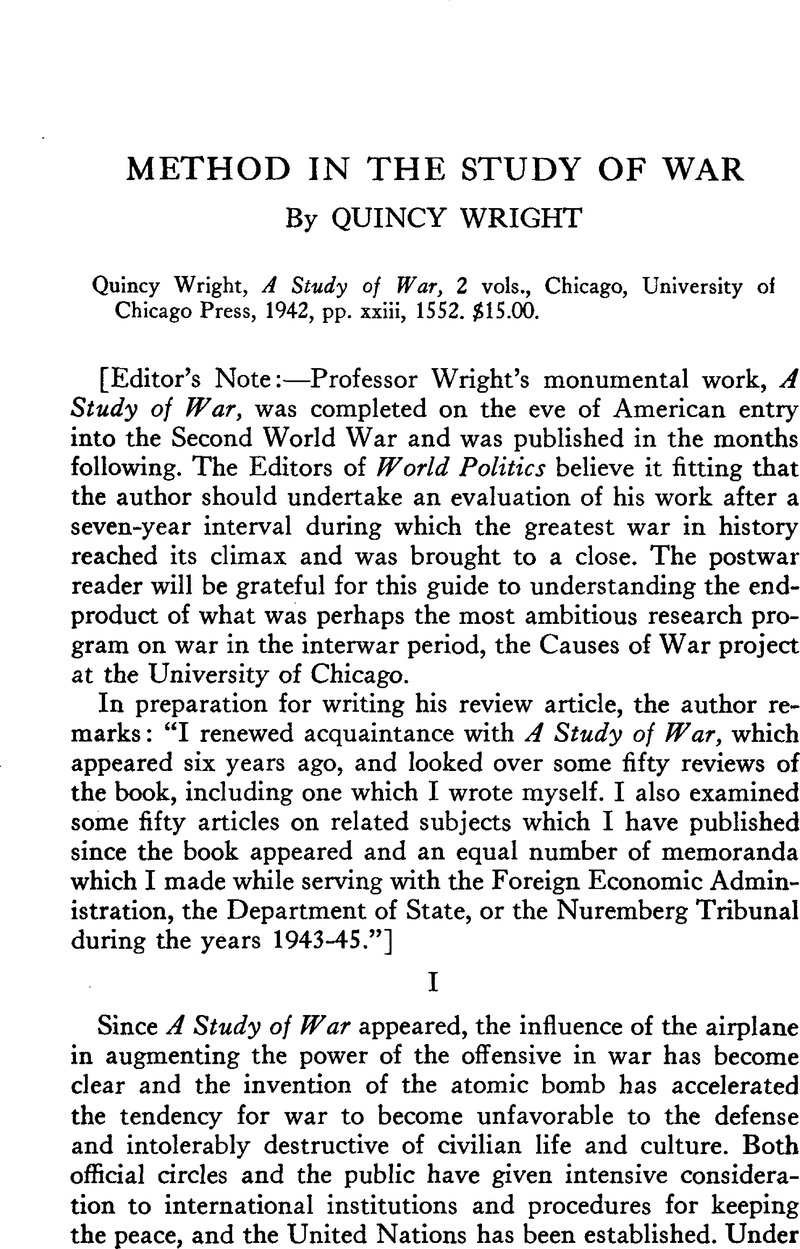No CrossRef data available.
Article contents
Method in the Study of War
Published online by Cambridge University Press: 18 July 2011
Abstract

- Type
- Review Article
- Information
- Copyright
- Copyright © Trustees of Princeton University 1949
References
1 Wright, Quincy, A Study of War, pp. 102–3Google Scholar; 218, n. 2; 569, 636 ff.
2 Ibid., Chaps. 35 and 36.
3 Ibid., Chaps. 12, 20, 21, and 22.
4 Ibid., Chaps. 13, 23, 24, and 25.
5 Ibid., Chaps. 10, 26, 27, 28, and 29.
6 Ibid., Chaps. 11, 30, 31, 32, and 33.
7 Ibid., Chaps. 34 and 37.
8 Ibid., Chaps. 38, 39, and 40.
9 Ibid., pp. 1299–1300, 1303–4.
10 P. xxi.
11 Myrdal, Gunnar, “Social Trends in America and Strategic Approaches to the Negr Problem,” Phylon, Vol. IX, No. 3 (1948), pp. 211–12.Google Scholar
12 Wright, , op. cit., pp. 682–4.Google Scholar See also pp. 1085, 1087, 1115–17, 1299, 1355 ff.
13 Adler, Mortimer, IIow to Think about War and Peace, New York, Simon arid Schuster, 1944, p. 55.Google Scholar
14 Ibid., p. 69.
15 Wright, , op. cit., p. 1284.Google Scholar
16 Ibid., p. 731 ff.
17 Ibid., pp. 5, 1207 ff., 1227ff., 1235 ff.
18 Ibid., pp. 1084–1117.
19 Ibid., p. 1432 ff. See also p. 1012 ff. Closely related is the distinction between techniques, functions, drives and theories (p. 18) utilized in the historical chapters; the distinction between government, nation, people, and state (p.19) utilized in the analytical parts; and the distinction between the military, sociological, psychological, and legal points of view (p. 20) utilized in Appendix 3 and Chapter 34. The concept of relations between measurable variables is especially utilized in Chapters 35 and 36.
20 The scientific, historical and practical causes of war are summarized on p. 731 ff., and the concepts and causes of war from the voluntaristic and deterministic points of view are summarized on p. 1235 ff.
21 Wright, , op. cit., pp. 5, 372ff.Google Scholar
22 Ibid., pp. 1240 ff., 1276 ff.
23 Ibid., p. 1284 ff.
24 Ibid., p. 402 ff.
25 Ibid., pp. 380 ff., 955, 1277 ff., 1338 ff.
26 Ibid., p. 1326 ff.
27 Ibid., p. 1334 ff.
28 Ibid., pp. 975 ff., 1332 if.
29 Ibid., p. 1493 if.
30 The need of sudden change is emphasized on pp. 937, 1345, and 1497, but the probabilitythat such change will involve war and the virtue of gradualness are emphasized on pp. 1040, 1236, and 1306. Friedrich, Carl J. comments on this point in his understanding review in The American Journal of Sociology, Vol. XLVIII, No. 4 (January 1943), pp. 508–11.CrossRefGoogle Scholar
31 Wright, , op. cit., pp. 315–16.Google Scholar
32 On the whole the book considered this transition necessary.
33 Wright, , op. cit., p. 938.Google Scholar I dealt with this problem in an article entitled “Accomplishments and Expectations of World Organization,” Yale Law Journal, Vol. 55, No. 5 (August 1946), pp. 870–884.




